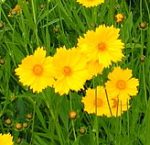 Large flowered tickseed is a clump forming herbaceous perennial and a member of the aster family, Asteraceae, that also includes sunflower, daisy, and lettuce. It is native to southeastern US where it grows in open woods, prairies, and roadsides. Plants are somewhat hairy and grow 1-2′ tall. The basal and lower leaves are lanceolate to spatulate while the upper leaves are often deeply 3-5 lobed. The 1-3″ wide flower heads are carried singly on long stalks and consist of about 8 toothed yellow ray flowers around a center of disc flowers. If the flowers are faithfully deadheaded the plants will bloom from late spring to late summer. Plants are short lived but spread by self-seeding and rhizomes and can become weedy. They may sprawl if not in sun and lean soil but can be cut back hard. Tolerant of drought and lean soil, this tickseed is a good choice for a cottage garden, meadow, or prairie. Several very good cultivars are available. Flowers are good for the vase. The genus name, Coreopsis, comes from the Greek words koris meaning bug and opsis meaning like/similar to and refers to the appearance of the seed. The specific epithet comes from the Latin words grandis meaning large, and flos meaning flower.
Large flowered tickseed is a clump forming herbaceous perennial and a member of the aster family, Asteraceae, that also includes sunflower, daisy, and lettuce. It is native to southeastern US where it grows in open woods, prairies, and roadsides. Plants are somewhat hairy and grow 1-2′ tall. The basal and lower leaves are lanceolate to spatulate while the upper leaves are often deeply 3-5 lobed. The 1-3″ wide flower heads are carried singly on long stalks and consist of about 8 toothed yellow ray flowers around a center of disc flowers. If the flowers are faithfully deadheaded the plants will bloom from late spring to late summer. Plants are short lived but spread by self-seeding and rhizomes and can become weedy. They may sprawl if not in sun and lean soil but can be cut back hard. Tolerant of drought and lean soil, this tickseed is a good choice for a cottage garden, meadow, or prairie. Several very good cultivars are available. Flowers are good for the vase. The genus name, Coreopsis, comes from the Greek words koris meaning bug and opsis meaning like/similar to and refers to the appearance of the seed. The specific epithet comes from the Latin words grandis meaning large, and flos meaning flower.
Type: Herbaceous perennial
Bloom: Single flower heads 1-3″ wide on long stalks with 8 toothed yellow ray flowers around a center of disc flowers; late spring through late summer
Size: 1-2′ H x 1′ W
Light:Full sun
Soil:Lean, dry to medium moist, well-drained
Hardiness: Zones 5-9
Care: Deadhead; divide every 2-3 years to renew vigor.
Pests and Diseases: None of significance but may be susceptible to leaf spot, powdery mildew, rust and crown rot.
Propagation: Seed, division in spring or fall
Companion Plants:Cone flower, blazing star, cranesbill, speedwell
Outstanding Selections:
‘Early Sunrise; (1.5’ tall, compact; double yellow flower heads)
‘Goldfink’ (9″ tall; 2″ wide single flower heads with yellow ray flowers and orange disc flowers)
‘Mayfield Giant (2-3’ tall; 2-4″ gold yellow flower heads)
‘Sunburst’ (2′ tall; semi-double golden yellow flower heads)
‘Sunray’ (2′ tall; 2′ double flower heads)